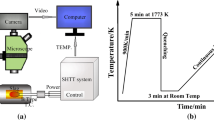Abstract
A mold flux is widely used to modify heat transfer rates in continuous casting, and crystallization of a mold flux has been identified as a primary factor that influences heat flux from the strand to the mold. By using an infrared radiation emitter, a radiative heat flux was applied to a copper mold covered with solid mold flux disk to simulate the heat transfer phenomena in continuous casting. By this technique it is possible to have a liquid layer, a crystalline layer and a glassy layer in contact with one another and, by varying the energy input, it is possible to study the dynamic nature of the film and its effect on the radiative and overall heat transfer rate. A general heat transfer model was also developed to allow the prediction of the effect of varying the thickness of the three potential layers in the flux film.
Similar content being viewed by others
References
J. Savage, and W. H. Pritchard, J. Iron Steel Ins. 8, 12 (1954).
K. C. Mills and A. B. Fox, Ironmak. Steelmak. 26, 32 (2005).
H. Tomono, P. Ackermann, W. Kurz, and W. Heinemann, Proc. Int. Conf. on Solid. Tech. in Foundry and Cast House, p. 524, The Metals Society, Warwick, USA (1980).
H. Tomono, W. Kurz, and W. Heinemann, Met. Trans. 409, 12B (1981).
S. Y. Choi and D. H. Lee, J. Non-Cryst. Solids, 3, 157 (2002).
M. M. Wolf, Steelmaking Conference Proceedings, p. 83, The Iron and Steel Society, Warrendale, PA, USA (1992).
M. Emi, ISS Steelmaking Proceedings. p. 623, The Iron and Steel Society, Warrendale, PA, USA (1991).
P. V. Ribound, M. Larrecq, Steelmaking Conference Proceedings, p. 23, The Iron and Steel Society, Warrendale, PA, USA (1979).
W. Wang and A. W. Cramb, Steel Res. Int. 271, 79 (2008).
M. Susa, K. Mills, M. Richardson, and D. Stewart, Ironmak. Steelmak. 623, 21(1994).
W. Wang and A.W. Cramb, AIST Transact. 155, 5 (2008)
W. Wang, Ph.D. Thesis, p. 107–120, Carnegie Mellon University, Pittsburgh, USA (2007).
J. Cho, H. Shibata, and M. Suzuki, ISIJ Int. 268, 38 (1998).
M. Susa, K. Nagata, and K.C. Mills, Ironmak. Steelmak. 372, 20(1993).
M. Susa, M. J. Richardson, R. Taylor, and D. Stewart, Ironmak. Steelmak. 279, 21(1994).
Y. Shiraishi, Handbook of physo-chemical properties at high temperature, Ch 10, ISIJ, Tokyo, Japan (1988).
K. Watanabe, M. Suzuki, K. Murakami, and T. Shiomi, Tetsu-to-Hagane 115, 83(1997).
S. Ohmiya, K. H. Tacke, and K. Schwerdtfeger, Ironmak. Steelmak. 24, 10(1983).
W. Wang and A. W. Cramb, ISIJ Int. 1864, 45(2005).
Author information
Authors and Affiliations
Corresponding author
Rights and permissions
About this article
Cite this article
Wang, W., Zhou, L. & Kezhuan, G. Effect of mold flux melting and crystal fraction dissolution on radiative heat transfer in continuous casting. Met. Mater. Int. 16, 913–920 (2010). https://doi.org/10.1007/s12540-010-1209-y
Received:
Accepted:
Published:
Issue Date:
DOI: https://doi.org/10.1007/s12540-010-1209-y




